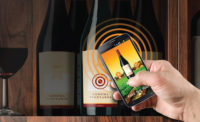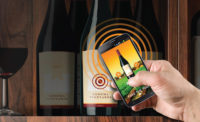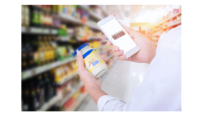Materials Technology: Labels
How smart labels engage and inform consumers
Did your soda just say something?

Smart packaging has come a long way – snack food bags can detect drunk drivers and beer bottles can play music – but more brands are investing in smart labels to connect brands and technology. With the potential to improve logistics, gather supply chain information and engage consumers, smart labels are becoming a top choice for companies in the digital age. In fact, the smart label market is estimated to reach $9.68 billion by 2020, with year-over-year growth of 14.24% since 2014.
Although adoption of smart labels has been slowed by a lack of standards and mechanical susceptibility, brands like Johnny Walker and Hershey’s are leading the charge. The benefits of smart labels in logistics, retail, manufacturing and healthcare, along with growing technological capabilities, are driving demand for the technology.1
More data, fewer problems
Smart labels are all about small data. While big data is used to collect massive amounts of information that is centrally managed and analyzed for patterns, small data focuses on a handful of attributes that require action when they change. For example, a smart label can collect small data about a temperature exceeding a threshold or a product becoming moist and subject to molding.
A research group at Clarkson University is pushing the limits of what smart labels can do. The group has created a low-cost, paper-based sensor that can determine when food or cosmetics spoil. Sensors use nanostructures to catch and bind pre-determined compounds to distinguish change. The freshness of the item can be detected based on the intensity of the transformation, which is projected as a color or electrical change. This simple innovation can show consumers when an item is safe to eat or use – even if past its “sell by date.”2
Applications for smart labels extend beyond food and beverage. Logistics is another key area. In the past, logistics companies may have attached an RFID tag to a shipping crate containing small, perishable products like medicine, yogurt or meat. With smart labels, tracking can be performed at the individual item level by simply applying a label to each individual product. In the healthcare space, smart labels can track the usage and disposal of pharmaceuticals as well as help control inventory.
While traditional silicon-based sensors are a good fit for many Internet of Things (IoT) use cases, they are more expensive and less flexible than the new breed of printed technology. And today’s grocery stores use standardized bar codes, but those are limited in the type of data they can store and display. Since product packaging can constitute 30 to 40% of the total cost of some products, smart packaging solutions that alter the packaging process are not often feasible – making labels the ideal place to incorporate technology into packaging.3
Real-world applications
The digital packaging market will gradually include traditional packaging formats that are remodeled to include digital elements like smart labels. For example, smart bottles are incorporated with digital technology to provide enhanced functionalities such as hydration reminders, medical dosage reminders, time and temperature indications and quality detection. The smart bottle segment within the digital packaging market itself is estimated to be reach U.S. $200 million by 2024.4
Diageo, a multinational alcoholic beverage firm, teamed up with smart label company ThinkFilm (thinkfilm-inc.com) to apply the technology to bottles of Johnny Walker Blue Label. The bottles use tags printed with Near Field Communication (NFC), which turns the bottle into a smart package compatible with most smartphones. The sensor tags can detect whether the bottle is open or sealed, and contain information that Diageo can use to send personalized messages to consumers who read the tags via their smartphones.5
Food companies can use smart labels to connect with consumers by offering additional nutritional and ingredient information. For example, since 2016 Hershey’s products have been printed with scannable QR codes that lead to a microsite detailing information on nutrition, ingredients, allergens, GMOs, product usage, and any advisories. The company hopes the initiative will pressure other companies to be more transparent with shoppers about ingredients, a priority for today’s consumers.
Intelligent packaging companies have high hopes for the future of smart labeling technology. SmartLabel™ (smartlabel.org), for example, seeks to lead packaged goods consumers into a new world where they can easily and instantly access detailed information about thousands of products. Each individual product will have its own landing page, which consumers will be able to access by scanning a QR code on the package, doing a web search, visiting a participating company’s web site or eventually through an app. SmartLabel’s goal is to be ubiquitous in the consumer packaged goods market, and the potential for growth is strong. A recent survey by Benenson Strategy Group found that 75% of consumers would be likely to use the technology.6
Uncover labeling solutions at PACK EXPO East
The digital labeling market is growing, driven by technologies like RFID, QR codes and barcodes. The latest innovations in digital labeling offers opportunities for old companies to re-evaluate their labeling strategies and a chance for emerging companies to invest in the right equipment at an early stage.
Packaging professionals seeking the latest in smart labeling can explore innovations at PACK EXPO East (April 16-18; Pennsylvania Convention Center, Philadelphia), produced by PMMI, The Association for Packaging and Processing Technologies. The show is located in Philadelphia, within 200 miles of a third of the nation’s consumer packaged goods companies, and will draw an expected 6,000 attendees and 400 suppliers of advanced packaging equipment, automation, robotics and controls, materials, containers, printing and labeling technologies. To register, visit packexpoeast.com.
-
http://www.prnewswire.com/news-releases/global-smart-label-market---forecasts-and-trends-2015-2020-300147447.html
-
http://northcountrynow.com/news/tech-developed-potsdam-can-detect-expired-food-0217223
-
https://www.forbes.com/sites/mikekavis/2015/02/17/the-smart-labels-that-will-power-the-internet-of-things/#41cb1fb42ba6
-
http://www.satprnews.com/2017/09/21/digital-packaging-market-industry-analysis-and-research-report-2017-2025/
-
https://www.forbes.com/sites/jenniferhicks/2015/03/02/johnnie-walker-smart-bottle-debuts-at-mobile-world-congress/#1df3af7d7ca1
- http://www.gmaonline.org/news-events/newsroom/new-smartlabel-initiative-gives-consumers-easy-access-to-detailed-ingredien/
PMMI, The Association for Packaging and Processing Technologies, represents more than 800 North American manufacturers and suppliers of equipment, components and materials as well as providers of related equipment and services to the packaging and processing industry. We work to advance a variety of industries by connecting consumer goods companies with manufacturing solutions through the world-class PACK EXPO portfolio of trade shows, leading trade media and a wide range of resources to empower our members. The PACK EXPO trade shows unite the world of packaging and processing to advance the industries they serve: PACK EXPO International, PACK EXPO Las Vegas, Healthcare Packaging EXPO, PACK EXPO East, EXPOPACK México, EXPO PACK Guadalajara and ProFood Tech. PMMI Media Group connects manufacturers to the latest solutions, trends and innovations in packaging and processing year-round through brands including Packaging World, Automation World, Healthcare Packaging, Contract Packaging, ProFood World and Packaging + Processing OEM. PMMI Business Drivers assist members in pursuing operational excellence through workforce development initiatives, deliver actionable business intelligence on economic, market and industry trends to support members’ growth strategies, and actively connect the supply chain throughout the year.
Learn more at pmmi.org and packexpo.com and PMMIMediaGroup.com.
Looking for a reprint of this article?
From high-res PDFs to custom plaques, order your copy today!







